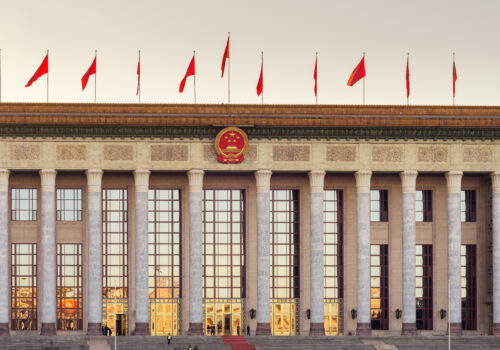Hong Kong highlights China’s policy of decoupling from US financial markets
As financial markets nervously adjust to President Donald Trump’s unpredictable tariff policy, an overlooked shift in US-China economic relations is taking place on the Hong Kong stock market. There, a Chinese technology company has turned its back on Wall Street and launched the world’s largest share offering of 2025.
The $4.6 billion initial public offering (IPO) by the battery manufacturer Contemporary Amperex Technology Co. (CATL) in late May was a clear riposte to a US Department of Defense decision to place the company on a watchlist for alleged links to the Chinese military. It also highlighted the fragility of business ties that once seemed to inextricably bind the world’s two largest economies.
The Chinese government is steering more and more of its companies away from New York for IPOs; the country’s second-largest car maker, Chery Automobile, is preparing to launch a $1.5 billion share issue in Hong Kong as well. About three-quarters of the largest twenty-five Chinese firms listed on Wall Street have set up parallel listings in Hong Kong in the past few years and already represent 60 percent of the value of shares listed there. The purpose of listing in Hong Kong is to create an escape valve if the United States follows through on its periodic threats to delist all Chinese stocks on Wall Street. The most recent such warning came from US Treasury Secretary Scott Bessent on April 9, when he declared that “everything is on the table” in response to a journalist’s question about the possibility of forced delistings. Chinese stocks in the United States have a total market capitalization of about $1.1 trillion, which, while no small change, is only a tiny portion of the roughly $52 trillion US markets.
American investors with accounts outside the United States can buy Chinese stocks in Hong Kong, and some fund managers have already shifted their holdings to the dual-listed shares there to protect against future disruptions. But many institutional investors whose governance rules do not allow for such foreign trading could not participate in the CATL IPO. The company specifically structured its share issue that way to avoid US regulatory oversight—a response to the Pentagon’s decision to blacklist the firm.
Hong Kong’s emergence as the market of choice for Chinese companies is no accident. Beijing has worked systematically to revive it as a regional financial center after many foreign investors and financial institutions retreated from the city in recent years, especially after the Chinese government’s began cracking down on mass political protests in 2019. The centerpiece of the financial market strategy is to establish Hong Kong as the largest venue for offshore transactions denominated in renminbi. Stocks are also part of the blueprint. While Chinese companies have been listing in Hong Kong for years, the stock market has gained prominence in China’s plans as US-China relations have worsened. A senior Chinese official said late last year that 80 percent of mainland businesses seeking an offshore listing are prioritizing Hong Kong, no doubt with a push from Beijing’s regulators.
The core issue for both Washington and Beijing is the national security implications of Chinese companies’ presence on Wall Street. Each US presidential administration over the past five years has sought to exclude companies regarded as part of China’s military-industrial complex from American financial markets. In 2020, the first Trump administration launched an effort to prohibit US investments in companies with ties to the Chinese government and military. This initiative resulted in the delisting of several large state-owned Chinese companies from US exchanges.
At the same time, Chinese regulators became increasingly concerned about US requirements for financial disclosure that they believed could reveal national secrets. That became a headline issue in the bilateral relationship after China refused, for many years, to allow US government auditors to inspect listed Chinese companies’ books. The US Congress eventually passed a law that mandated mass delisting if Beijing did not cooperate. A 2022 agreement that permitted American oversight defused the standoff, but the remaining Chinese state-owned firms voluntarily delisted from Wall Street on that accord was finalized. Since 2021, China has stepped up its scrutiny of all Chinese companies seeking to list in the United States.
These issues have often been most visible when they involve publicly listed companies. However, US policymakers have also focused on restricting US venture capital and private equity investments in China, as well as Chinese investments in the United States. American venture capital and private equity investments in China in 2024 fell to $1.62 billion from a peak of $40.81 billion in 2018, and President Donald Trump issued a national security memorandum in February outlining plans to further restrict these capital flows.
There is a domestic political dimension to Beijing’s decision to expand its oversight of public listings: Control of China’s most important private sector companies, including the e-commerce giant Alibaba Group. Chinese leader Xi Jinping’s campaign to bring private conglomerates to heel has been closely tied to the regulation of foreign listings. The squeeze on corporate fundraising on Wall Street began in late 2020 when Beijing blocked a huge, planned IPO for Ant Group, the financial arm of Alibaba, after Alibaba Chairman Jack Ma criticized financial regulators. That action came as the first restrictions on US investments in Chinese companies were imposed.
From that point on, tightening controls over US listings appeared to occur in lockstep with deteriorating US-China ties. As the Biden administration broadened restrictions on Chinese companies by American investors in 2021, Beijing sought to delay a huge IPO by the Chinese ride-hailing giant Didi Chuxing. China then forced the company to delist after it defied the regulators and proceeded with the deal. Beijing followed that sanction with a raft of regulations mandating stricter oversight of all companies applying for foreign listings. Chinese IPOs in the United States have never recovered. According to the US-China Economic and Security Review Commission, forty-eight Chinese companies issued IPOs in the United States between January 2024 and early March 2025, raising a total of $2.1 billion. By contrast, thirty-two companies raised $12.1 billion in 2021.
Even before the CATL listing, IPOs in Hong Kong had risen sharply this year. The number of deals was up 25 percent in the first quarter, and the total value of those listings increased 287 percent to about $2.3 billion. The ten largest IPOs so far have been Chinese companies.
Listing in Hong Kong certainly has its drawbacks compared with Wall Street. It is a more volatile market with trading volumes far below the levels on US exchanges and lower valuations relative to earnings. A Hong Kong listing generally doesn’t command the prestige of the American exchanges; that can mean less favorable terms on other forms of financing than a US-listed company might be offered. Hong Kong’s listing regulations are also stricter than on Wall Street, and an estimated 170 small Chinese companies listed in the United States may not have the option to obtain dual listings there. However, Hong Kong offers access to a largely untapped pool of Chinese investors through an official program that enables mainlanders to buy and sell Hong Kong shares, including stocks like Alibaba that are not listed on Chinese exchanges. As of late February, investors based in China held about 12 percent of Hong Kong shares, compared with 5 percent at the end of 2020. Their trades accounted for about one-quarter of daily turnover, up from 16 percent a year ago.
Ultimately, while the lure of China’s army of retail investors might provide some consolation for companies that might lose access to the US markets, the Chinese government is the real beneficiary Beijing is prepared to exchange the financial advantages of a market it can’t control for the comfort of a city that responds to its every whim. Its actions over the past five years suggest a calculus that the political benefits of an international financial center with Chinese characteristics will outweigh the pain that decoupling inflicts on China’s private sector.
Jeremy Mark is a nonresident senior fellow with the Atlantic Council’s GeoEconomics Center. He previously worked for the International Monetary Fund and the Asian Wall Street Journal.

At the intersection of economics, finance, and foreign policy, the GeoEconomics Center is a translation hub with the goal of helping shape a better global economic future.
Further reading
Wed, Mar 12, 2025
China’s economic plans prioritize consumption—but only on paper
Sinographs By Jeremy Mark
At last week's meeting of the National People's Congress, China declared consumption as the number one priority. But will the spending plans actually support consumers and businesses?
Mon, May 12, 2025
Experts react: The US and China just agreed to dramatically reduce tariffs on each other, for now. What’s next?
Experts react By
Our experts explain what the ninety-day reduction in US-China tariffs means for Washington, Beijing, and the global trading system.
Thu, Feb 13, 2025
Beijing fails to reassure skeptical investors and responds with more regulation
Sinographs By Jeremy Mark
Beijing has tried to stabilize its struggling, volatile stock market by building up institutional investors, but it will take more than rules and action plans to change China’s market psychology.



